Human Resource Management Models and Practices
VerifiedAdded on 2020/02/17
|16
|4873
|177
AI Summary
This assignment delves into the complexities of human resource management (HRM) by exploring different HRM models and their practical applications. It examines how these models influence workplace flexibility, employee satisfaction, and productivity. The analysis also highlights the importance of effective communication between employees and management, emphasizing its role in shaping organizational performance. Furthermore, the assignment sheds light on the significance of equal opportunities and training programs in fostering a positive and productive work environment.
Contribute Materials
Your contribution can guide someone’s learning journey. Share your
documents today.
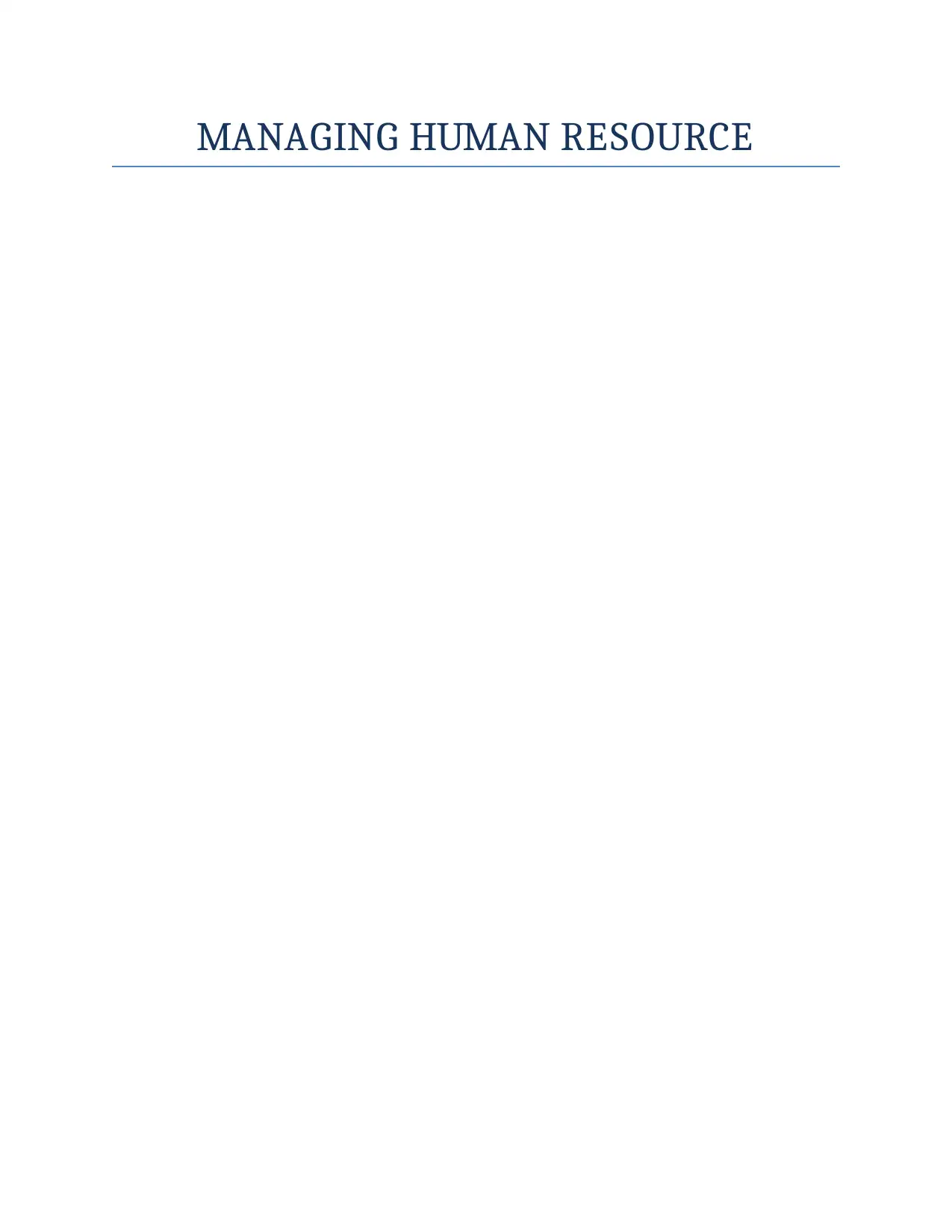
MANAGING HUMAN RESOURCE
Secure Best Marks with AI Grader
Need help grading? Try our AI Grader for instant feedback on your assignments.
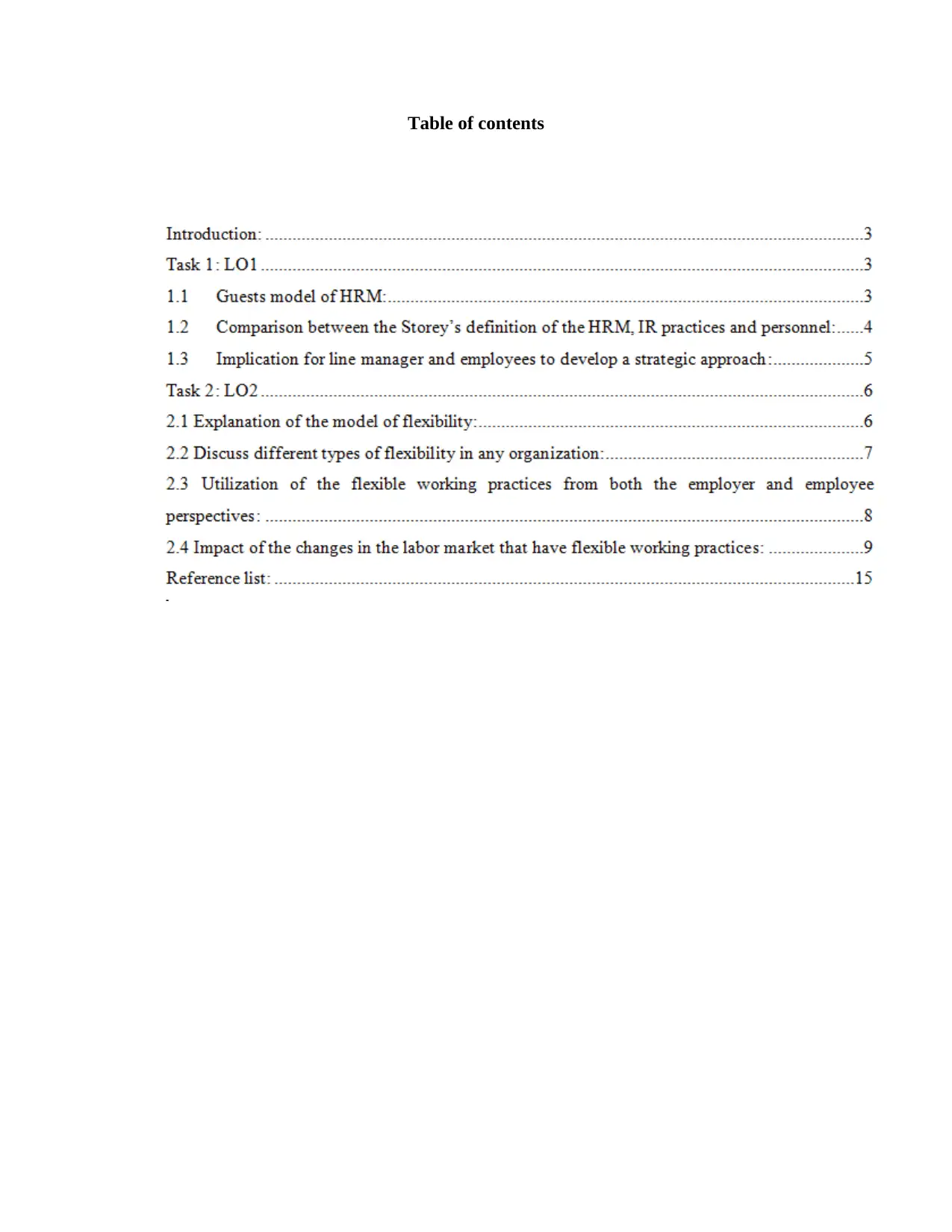
Table of contents

Introduction:
Over the last few decades, the human resource management has become a very popular term in
top managerial approaches. It is usually aimed to settle an order in the employment relationship
within any organization to ensure that the employees’ efforts remains strategically in focus in
order to achieve superior quality organizational and individual performances. In the recent times,
all of the organization is now paying attention to the bonding between the employees and HR
practices so an effective organizational performance can be achieved. This assignment is
intended to describe HRM as the approaches to manage the human resource in Unilever.
Task 1: LO1
1.1 Guests model of HRM:
Guest’s model generally focuses on the differentiation between the compliances and
commitments. According to this model, planning in Unilever must involve a pursuit for
enhancing the venture through integration and utilization of the human resource for
implementing their unique capabilities in the work. As opined by Cascio (2012), Guests model
depicts 6 different dimensions of the analysis that are Human Resource Management strategy,
the HRM outcomes, Human Resource Management practices, outcomes of performance,
outcomes depicting financial matters and behavioral outcomes. The model focuses on the
assumption that the processes of HRM are not ideal to the traditional process of personnel
management. This model implicitly embodies on a belief that the fundamental elements that
HRM approach like commitment, which is directly related with different consequences of
business. The Guest model argues that the HRM in the Unilever must be involved the designing
practices and policies of the business for achieving some outcomes like high commitment from
the employee, strategic integration in the organization, high level of flexibilityand adaptability
for the workforce and a quality workforce for organization. Strategic integration assured that the
business plan of the organization isimplemented through the properly designed policies and
practices of the HR (Stone, 2013).
Over the last few decades, the human resource management has become a very popular term in
top managerial approaches. It is usually aimed to settle an order in the employment relationship
within any organization to ensure that the employees’ efforts remains strategically in focus in
order to achieve superior quality organizational and individual performances. In the recent times,
all of the organization is now paying attention to the bonding between the employees and HR
practices so an effective organizational performance can be achieved. This assignment is
intended to describe HRM as the approaches to manage the human resource in Unilever.
Task 1: LO1
1.1 Guests model of HRM:
Guest’s model generally focuses on the differentiation between the compliances and
commitments. According to this model, planning in Unilever must involve a pursuit for
enhancing the venture through integration and utilization of the human resource for
implementing their unique capabilities in the work. As opined by Cascio (2012), Guests model
depicts 6 different dimensions of the analysis that are Human Resource Management strategy,
the HRM outcomes, Human Resource Management practices, outcomes of performance,
outcomes depicting financial matters and behavioral outcomes. The model focuses on the
assumption that the processes of HRM are not ideal to the traditional process of personnel
management. This model implicitly embodies on a belief that the fundamental elements that
HRM approach like commitment, which is directly related with different consequences of
business. The Guest model argues that the HRM in the Unilever must be involved the designing
practices and policies of the business for achieving some outcomes like high commitment from
the employee, strategic integration in the organization, high level of flexibilityand adaptability
for the workforce and a quality workforce for organization. Strategic integration assured that the
business plan of the organization isimplemented through the properly designed policies and
practices of the HR (Stone, 2013).
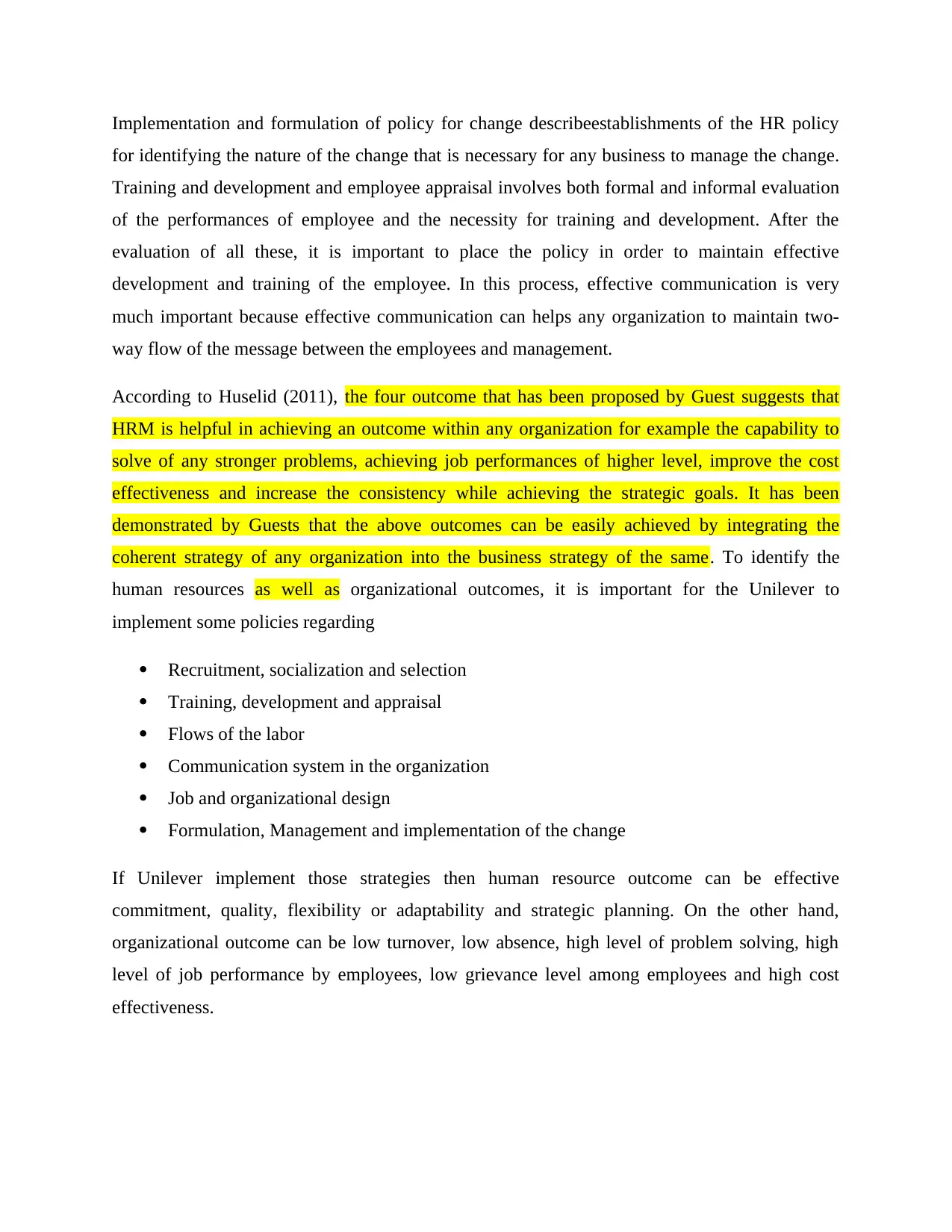
Implementation and formulation of policy for change describeestablishments of the HR policy
for identifying the nature of the change that is necessary for any business to manage the change.
Training and development and employee appraisal involves both formal and informal evaluation
of the performances of employee and the necessity for training and development. After the
evaluation of all these, it is important to place the policy in order to maintain effective
development and training of the employee. In this process, effective communication is very
much important because effective communication can helps any organization to maintain two-
way flow of the message between the employees and management.
According to Huselid (2011), the four outcome that has been proposed by Guest suggests that
HRM is helpful in achieving an outcome within any organization for example the capability to
solve of any stronger problems, achieving job performances of higher level, improve the cost
effectiveness and increase the consistency while achieving the strategic goals. It has been
demonstrated by Guests that the above outcomes can be easily achieved by integrating the
coherent strategy of any organization into the business strategy of the same. To identify the
human resources as well as organizational outcomes, it is important for the Unilever to
implement some policies regarding
Recruitment, socialization and selection
Training, development and appraisal
Flows of the labor
Communication system in the organization
Job and organizational design
Formulation, Management and implementation of the change
If Unilever implement those strategies then human resource outcome can be effective
commitment, quality, flexibility or adaptability and strategic planning. On the other hand,
organizational outcome can be low turnover, low absence, high level of problem solving, high
level of job performance by employees, low grievance level among employees and high cost
effectiveness.
for identifying the nature of the change that is necessary for any business to manage the change.
Training and development and employee appraisal involves both formal and informal evaluation
of the performances of employee and the necessity for training and development. After the
evaluation of all these, it is important to place the policy in order to maintain effective
development and training of the employee. In this process, effective communication is very
much important because effective communication can helps any organization to maintain two-
way flow of the message between the employees and management.
According to Huselid (2011), the four outcome that has been proposed by Guest suggests that
HRM is helpful in achieving an outcome within any organization for example the capability to
solve of any stronger problems, achieving job performances of higher level, improve the cost
effectiveness and increase the consistency while achieving the strategic goals. It has been
demonstrated by Guests that the above outcomes can be easily achieved by integrating the
coherent strategy of any organization into the business strategy of the same. To identify the
human resources as well as organizational outcomes, it is important for the Unilever to
implement some policies regarding
Recruitment, socialization and selection
Training, development and appraisal
Flows of the labor
Communication system in the organization
Job and organizational design
Formulation, Management and implementation of the change
If Unilever implement those strategies then human resource outcome can be effective
commitment, quality, flexibility or adaptability and strategic planning. On the other hand,
organizational outcome can be low turnover, low absence, high level of problem solving, high
level of job performance by employees, low grievance level among employees and high cost
effectiveness.
Secure Best Marks with AI Grader
Need help grading? Try our AI Grader for instant feedback on your assignments.
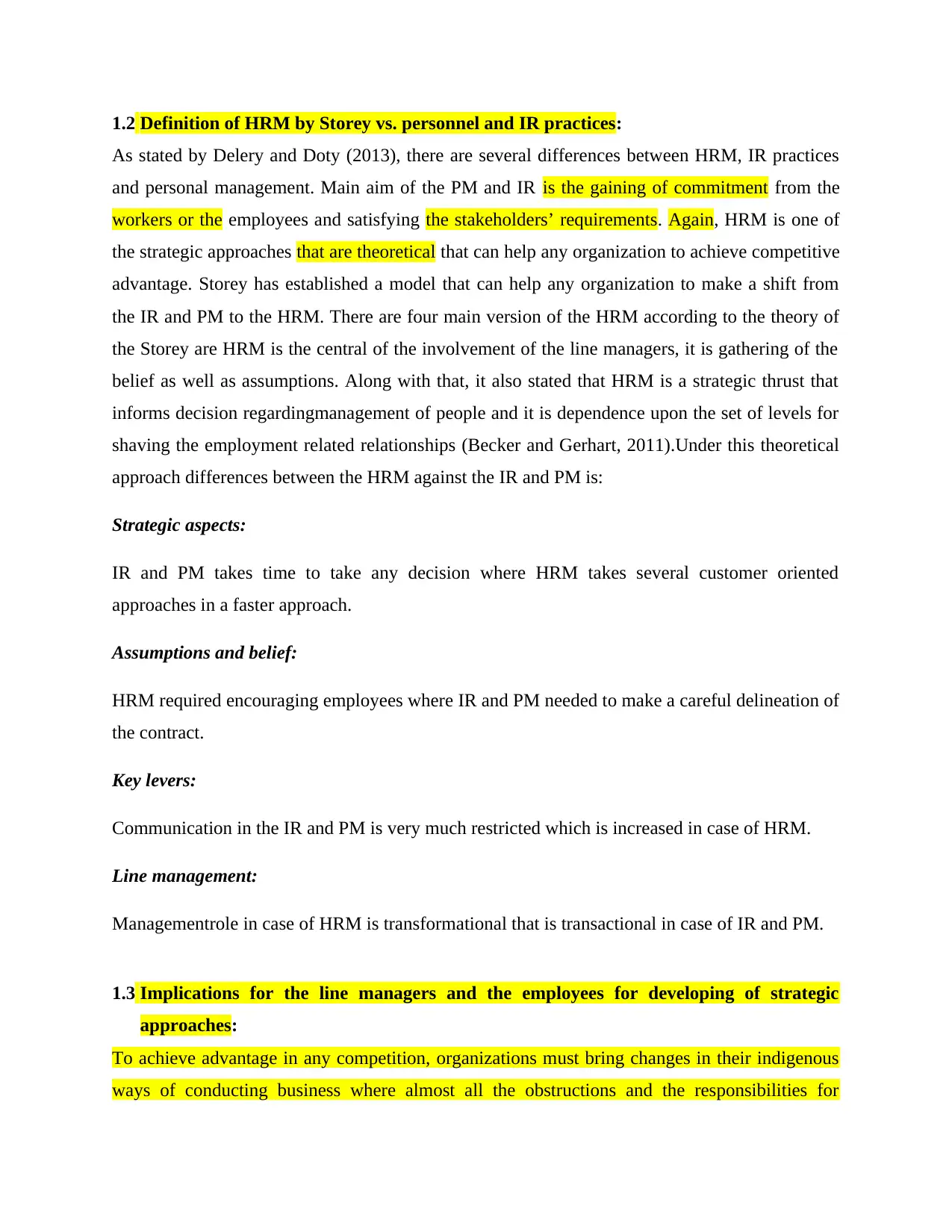
1.2 Definition of HRM by Storey vs. personnel and IR practices:
As stated by Delery and Doty (2013), there are several differences between HRM, IR practices
and personal management. Main aim of the PM and IR is the gaining of commitment from the
workers or the employees and satisfying the stakeholders’ requirements. Again, HRM is one of
the strategic approaches that are theoretical that can help any organization to achieve competitive
advantage. Storey has established a model that can help any organization to make a shift from
the IR and PM to the HRM. There are four main version of the HRM according to the theory of
the Storey are HRM is the central of the involvement of the line managers, it is gathering of the
belief as well as assumptions. Along with that, it also stated that HRM is a strategic thrust that
informs decision regardingmanagement of people and it is dependence upon the set of levels for
shaving the employment related relationships (Becker and Gerhart, 2011).Under this theoretical
approach differences between the HRM against the IR and PM is:
Strategic aspects:
IR and PM takes time to take any decision where HRM takes several customer oriented
approaches in a faster approach.
Assumptions and belief:
HRM required encouraging employees where IR and PM needed to make a careful delineation of
the contract.
Key levers:
Communication in the IR and PM is very much restricted which is increased in case of HRM.
Line management:
Managementrole in case of HRM is transformational that is transactional in case of IR and PM.
1.3 Implications for the line managers and the employees for developing of strategic
approaches:
To achieve advantage in any competition, organizations must bring changes in their indigenous
ways of conducting business where almost all the obstructions and the responsibilities for
As stated by Delery and Doty (2013), there are several differences between HRM, IR practices
and personal management. Main aim of the PM and IR is the gaining of commitment from the
workers or the employees and satisfying the stakeholders’ requirements. Again, HRM is one of
the strategic approaches that are theoretical that can help any organization to achieve competitive
advantage. Storey has established a model that can help any organization to make a shift from
the IR and PM to the HRM. There are four main version of the HRM according to the theory of
the Storey are HRM is the central of the involvement of the line managers, it is gathering of the
belief as well as assumptions. Along with that, it also stated that HRM is a strategic thrust that
informs decision regardingmanagement of people and it is dependence upon the set of levels for
shaving the employment related relationships (Becker and Gerhart, 2011).Under this theoretical
approach differences between the HRM against the IR and PM is:
Strategic aspects:
IR and PM takes time to take any decision where HRM takes several customer oriented
approaches in a faster approach.
Assumptions and belief:
HRM required encouraging employees where IR and PM needed to make a careful delineation of
the contract.
Key levers:
Communication in the IR and PM is very much restricted which is increased in case of HRM.
Line management:
Managementrole in case of HRM is transformational that is transactional in case of IR and PM.
1.3 Implications for the line managers and the employees for developing of strategic
approaches:
To achieve advantage in any competition, organizations must bring changes in their indigenous
ways of conducting business where almost all the obstructions and the responsibilities for
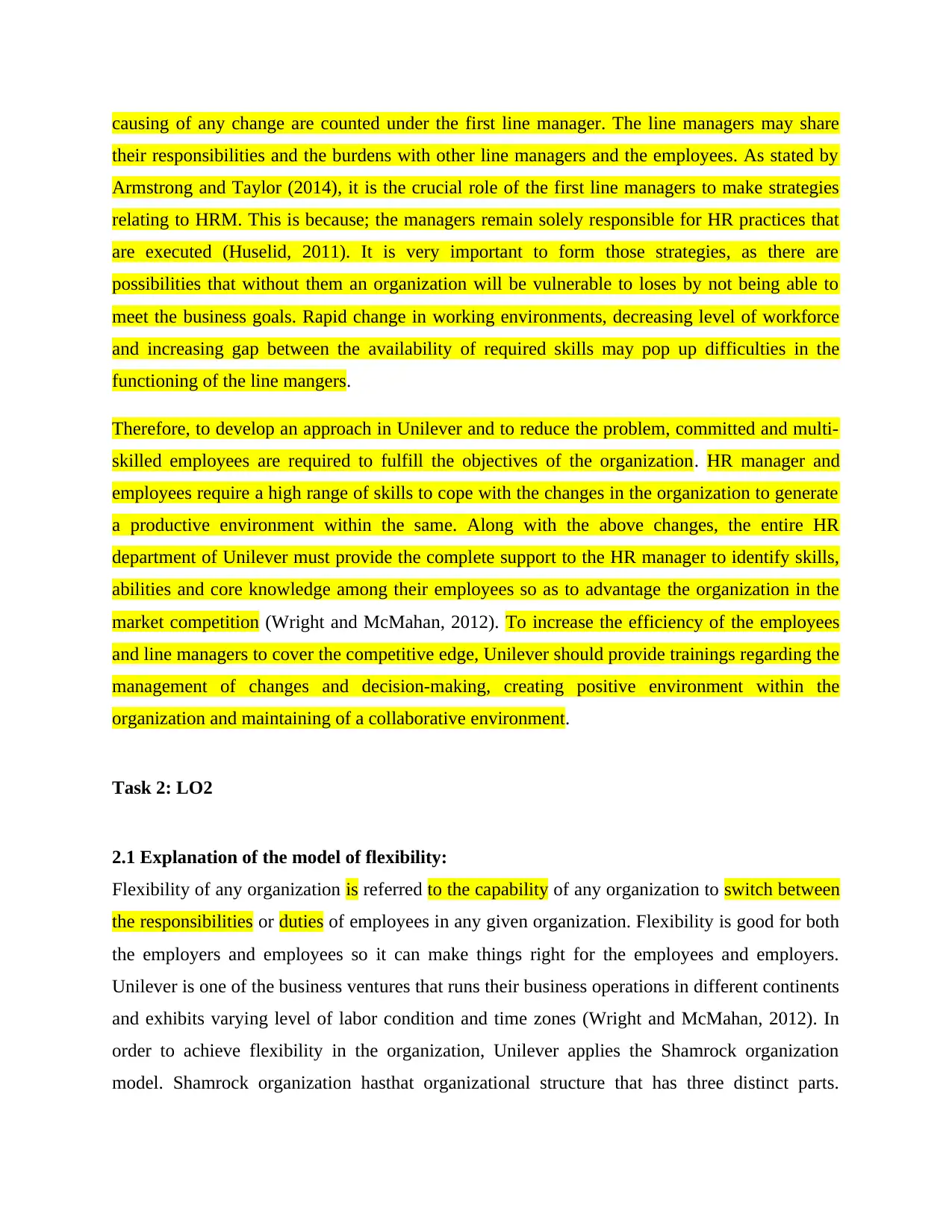
causing of any change are counted under the first line manager. The line managers may share
their responsibilities and the burdens with other line managers and the employees. As stated by
Armstrong and Taylor (2014), it is the crucial role of the first line managers to make strategies
relating to HRM. This is because; the managers remain solely responsible for HR practices that
are executed (Huselid, 2011). It is very important to form those strategies, as there are
possibilities that without them an organization will be vulnerable to loses by not being able to
meet the business goals. Rapid change in working environments, decreasing level of workforce
and increasing gap between the availability of required skills may pop up difficulties in the
functioning of the line mangers.
Therefore, to develop an approach in Unilever and to reduce the problem, committed and multi-
skilled employees are required to fulfill the objectives of the organization. HR manager and
employees require a high range of skills to cope with the changes in the organization to generate
a productive environment within the same. Along with the above changes, the entire HR
department of Unilever must provide the complete support to the HR manager to identify skills,
abilities and core knowledge among their employees so as to advantage the organization in the
market competition (Wright and McMahan, 2012). To increase the efficiency of the employees
and line managers to cover the competitive edge, Unilever should provide trainings regarding the
management of changes and decision-making, creating positive environment within the
organization and maintaining of a collaborative environment.
Task 2: LO2
2.1 Explanation of the model of flexibility:
Flexibility of any organization is referred to the capability of any organization to switch between
the responsibilities or duties of employees in any given organization. Flexibility is good for both
the employers and employees so it can make things right for the employees and employers.
Unilever is one of the business ventures that runs their business operations in different continents
and exhibits varying level of labor condition and time zones (Wright and McMahan, 2012). In
order to achieve flexibility in the organization, Unilever applies the Shamrock organization
model. Shamrock organization hasthat organizational structure that has three distinct parts.
their responsibilities and the burdens with other line managers and the employees. As stated by
Armstrong and Taylor (2014), it is the crucial role of the first line managers to make strategies
relating to HRM. This is because; the managers remain solely responsible for HR practices that
are executed (Huselid, 2011). It is very important to form those strategies, as there are
possibilities that without them an organization will be vulnerable to loses by not being able to
meet the business goals. Rapid change in working environments, decreasing level of workforce
and increasing gap between the availability of required skills may pop up difficulties in the
functioning of the line mangers.
Therefore, to develop an approach in Unilever and to reduce the problem, committed and multi-
skilled employees are required to fulfill the objectives of the organization. HR manager and
employees require a high range of skills to cope with the changes in the organization to generate
a productive environment within the same. Along with the above changes, the entire HR
department of Unilever must provide the complete support to the HR manager to identify skills,
abilities and core knowledge among their employees so as to advantage the organization in the
market competition (Wright and McMahan, 2012). To increase the efficiency of the employees
and line managers to cover the competitive edge, Unilever should provide trainings regarding the
management of changes and decision-making, creating positive environment within the
organization and maintaining of a collaborative environment.
Task 2: LO2
2.1 Explanation of the model of flexibility:
Flexibility of any organization is referred to the capability of any organization to switch between
the responsibilities or duties of employees in any given organization. Flexibility is good for both
the employers and employees so it can make things right for the employees and employers.
Unilever is one of the business ventures that runs their business operations in different continents
and exhibits varying level of labor condition and time zones (Wright and McMahan, 2012). In
order to achieve flexibility in the organization, Unilever applies the Shamrock organization
model. Shamrock organization hasthat organizational structure that has three distinct parts.
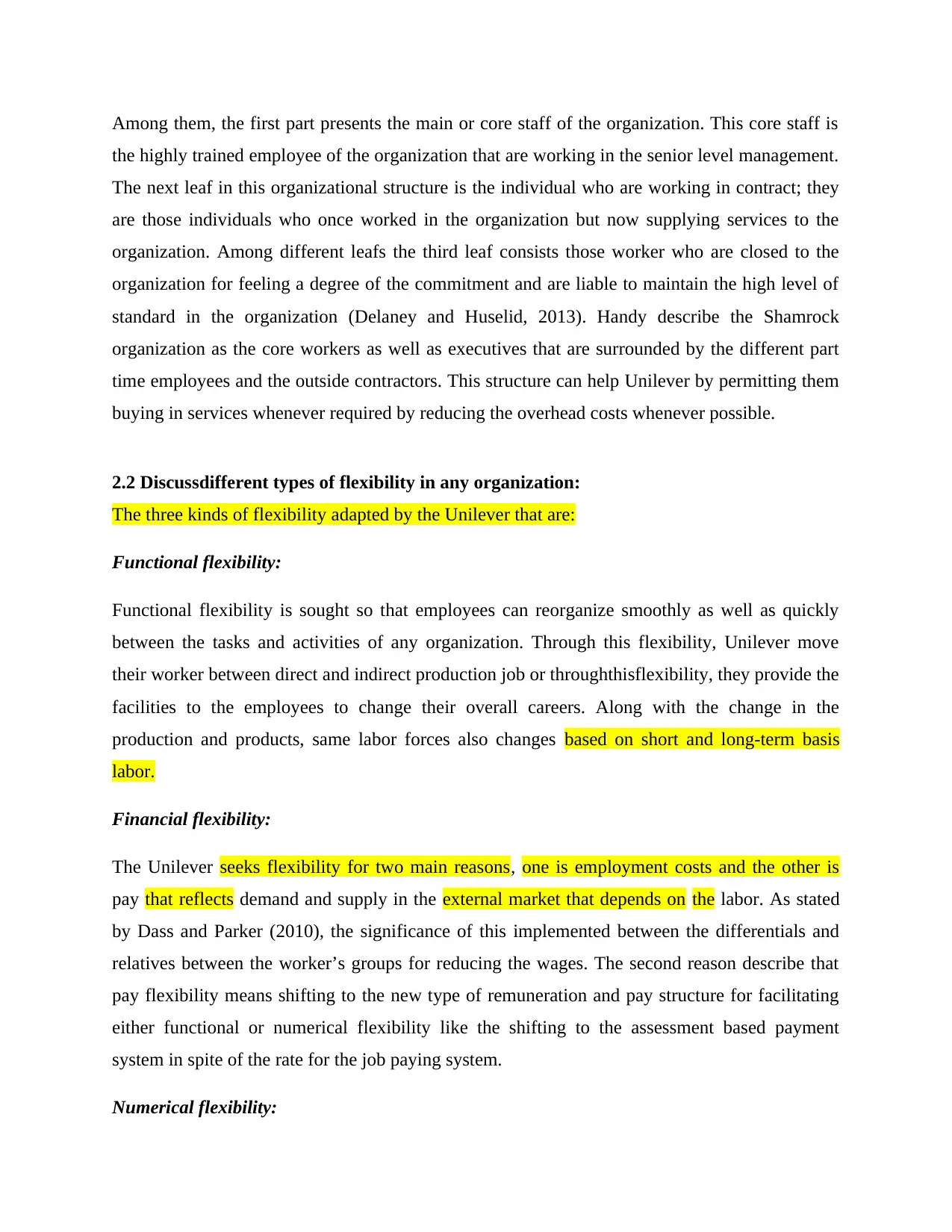
Among them, the first part presents the main or core staff of the organization. This core staff is
the highly trained employee of the organization that are working in the senior level management.
The next leaf in this organizational structure is the individual who are working in contract; they
are those individuals who once worked in the organization but now supplying services to the
organization. Among different leafs the third leaf consists those worker who are closed to the
organization for feeling a degree of the commitment and are liable to maintain the high level of
standard in the organization (Delaney and Huselid, 2013). Handy describe the Shamrock
organization as the core workers as well as executives that are surrounded by the different part
time employees and the outside contractors. This structure can help Unilever by permitting them
buying in services whenever required by reducing the overhead costs whenever possible.
2.2 Discussdifferent types of flexibility in any organization:
The three kinds of flexibility adapted by the Unilever that are:
Functional flexibility:
Functional flexibility is sought so that employees can reorganize smoothly as well as quickly
between the tasks and activities of any organization. Through this flexibility, Unilever move
their worker between direct and indirect production job or throughthisflexibility, they provide the
facilities to the employees to change their overall careers. Along with the change in the
production and products, same labor forces also changes based on short and long-term basis
labor.
Financial flexibility:
The Unilever seeks flexibility for two main reasons, one is employment costs and the other is
pay that reflects demand and supply in the external market that depends on the labor. As stated
by Dass and Parker (2010), the significance of this implemented between the differentials and
relatives between the worker’s groups for reducing the wages. The second reason describe that
pay flexibility means shifting to the new type of remuneration and pay structure for facilitating
either functional or numerical flexibility like the shifting to the assessment based payment
system in spite of the rate for the job paying system.
Numerical flexibility:
the highly trained employee of the organization that are working in the senior level management.
The next leaf in this organizational structure is the individual who are working in contract; they
are those individuals who once worked in the organization but now supplying services to the
organization. Among different leafs the third leaf consists those worker who are closed to the
organization for feeling a degree of the commitment and are liable to maintain the high level of
standard in the organization (Delaney and Huselid, 2013). Handy describe the Shamrock
organization as the core workers as well as executives that are surrounded by the different part
time employees and the outside contractors. This structure can help Unilever by permitting them
buying in services whenever required by reducing the overhead costs whenever possible.
2.2 Discussdifferent types of flexibility in any organization:
The three kinds of flexibility adapted by the Unilever that are:
Functional flexibility:
Functional flexibility is sought so that employees can reorganize smoothly as well as quickly
between the tasks and activities of any organization. Through this flexibility, Unilever move
their worker between direct and indirect production job or throughthisflexibility, they provide the
facilities to the employees to change their overall careers. Along with the change in the
production and products, same labor forces also changes based on short and long-term basis
labor.
Financial flexibility:
The Unilever seeks flexibility for two main reasons, one is employment costs and the other is
pay that reflects demand and supply in the external market that depends on the labor. As stated
by Dass and Parker (2010), the significance of this implemented between the differentials and
relatives between the worker’s groups for reducing the wages. The second reason describe that
pay flexibility means shifting to the new type of remuneration and pay structure for facilitating
either functional or numerical flexibility like the shifting to the assessment based payment
system in spite of the rate for the job paying system.
Numerical flexibility:
Paraphrase This Document
Need a fresh take? Get an instant paraphrase of this document with our AI Paraphraser
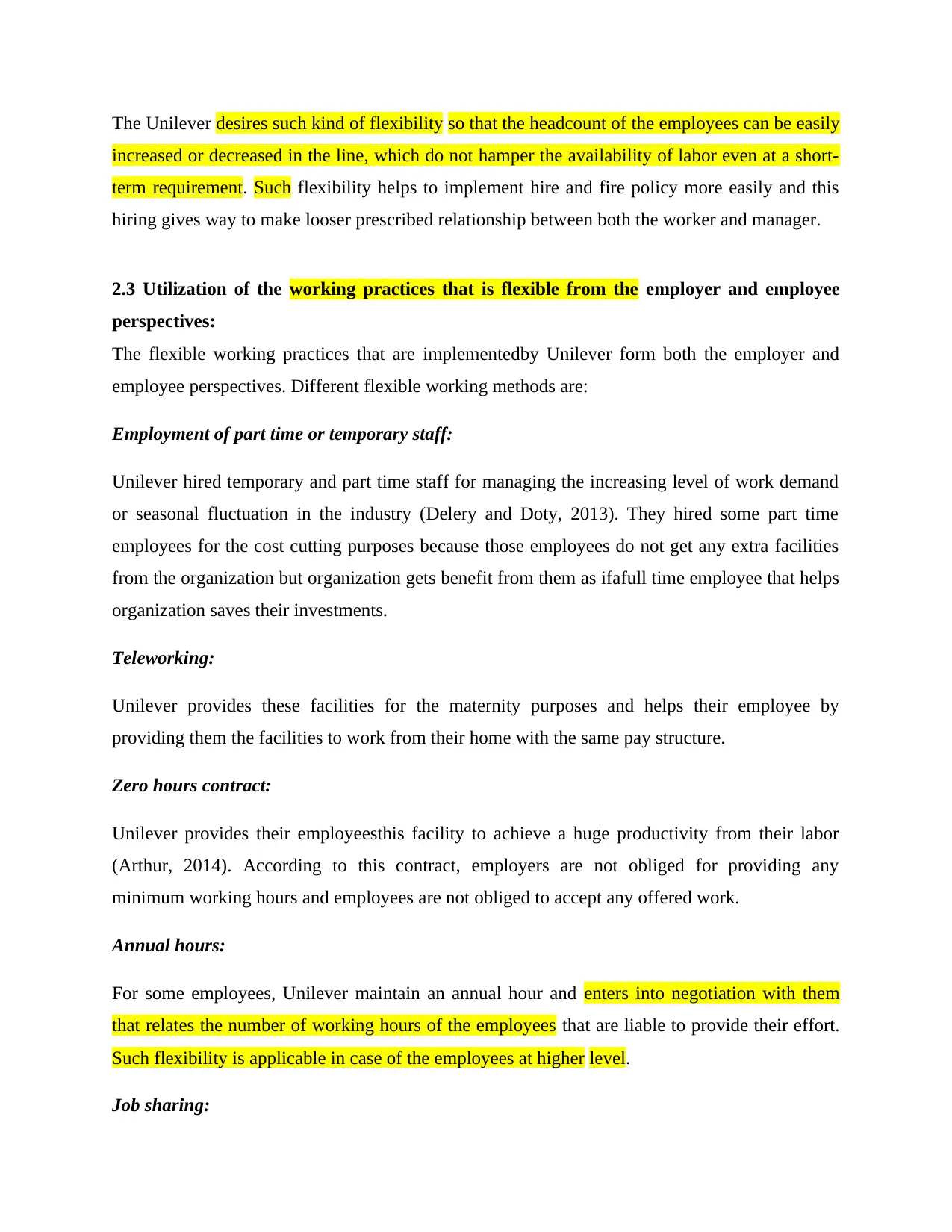
The Unilever desires such kind of flexibility so that the headcount of the employees can be easily
increased or decreased in the line, which do not hamper the availability of labor even at a short-
term requirement. Such flexibility helps to implement hire and fire policy more easily and this
hiring gives way to make looser prescribed relationship between both the worker and manager.
2.3 Utilization of the working practices that is flexible from the employer and employee
perspectives:
The flexible working practices that are implementedby Unilever form both the employer and
employee perspectives. Different flexible working methods are:
Employment of part time or temporary staff:
Unilever hired temporary and part time staff for managing the increasing level of work demand
or seasonal fluctuation in the industry (Delery and Doty, 2013). They hired some part time
employees for the cost cutting purposes because those employees do not get any extra facilities
from the organization but organization gets benefit from them as ifafull time employee that helps
organization saves their investments.
Teleworking:
Unilever provides these facilities for the maternity purposes and helps their employee by
providing them the facilities to work from their home with the same pay structure.
Zero hours contract:
Unilever provides their employeesthis facility to achieve a huge productivity from their labor
(Arthur, 2014). According to this contract, employers are not obliged for providing any
minimum working hours and employees are not obliged to accept any offered work.
Annual hours:
For some employees, Unilever maintain an annual hour and enters into negotiation with them
that relates the number of working hours of the employees that are liable to provide their effort.
Such flexibility is applicable in case of the employees at higher level.
Job sharing:
increased or decreased in the line, which do not hamper the availability of labor even at a short-
term requirement. Such flexibility helps to implement hire and fire policy more easily and this
hiring gives way to make looser prescribed relationship between both the worker and manager.
2.3 Utilization of the working practices that is flexible from the employer and employee
perspectives:
The flexible working practices that are implementedby Unilever form both the employer and
employee perspectives. Different flexible working methods are:
Employment of part time or temporary staff:
Unilever hired temporary and part time staff for managing the increasing level of work demand
or seasonal fluctuation in the industry (Delery and Doty, 2013). They hired some part time
employees for the cost cutting purposes because those employees do not get any extra facilities
from the organization but organization gets benefit from them as ifafull time employee that helps
organization saves their investments.
Teleworking:
Unilever provides these facilities for the maternity purposes and helps their employee by
providing them the facilities to work from their home with the same pay structure.
Zero hours contract:
Unilever provides their employeesthis facility to achieve a huge productivity from their labor
(Arthur, 2014). According to this contract, employers are not obliged for providing any
minimum working hours and employees are not obliged to accept any offered work.
Annual hours:
For some employees, Unilever maintain an annual hour and enters into negotiation with them
that relates the number of working hours of the employees that are liable to provide their effort.
Such flexibility is applicable in case of the employees at higher level.
Job sharing:
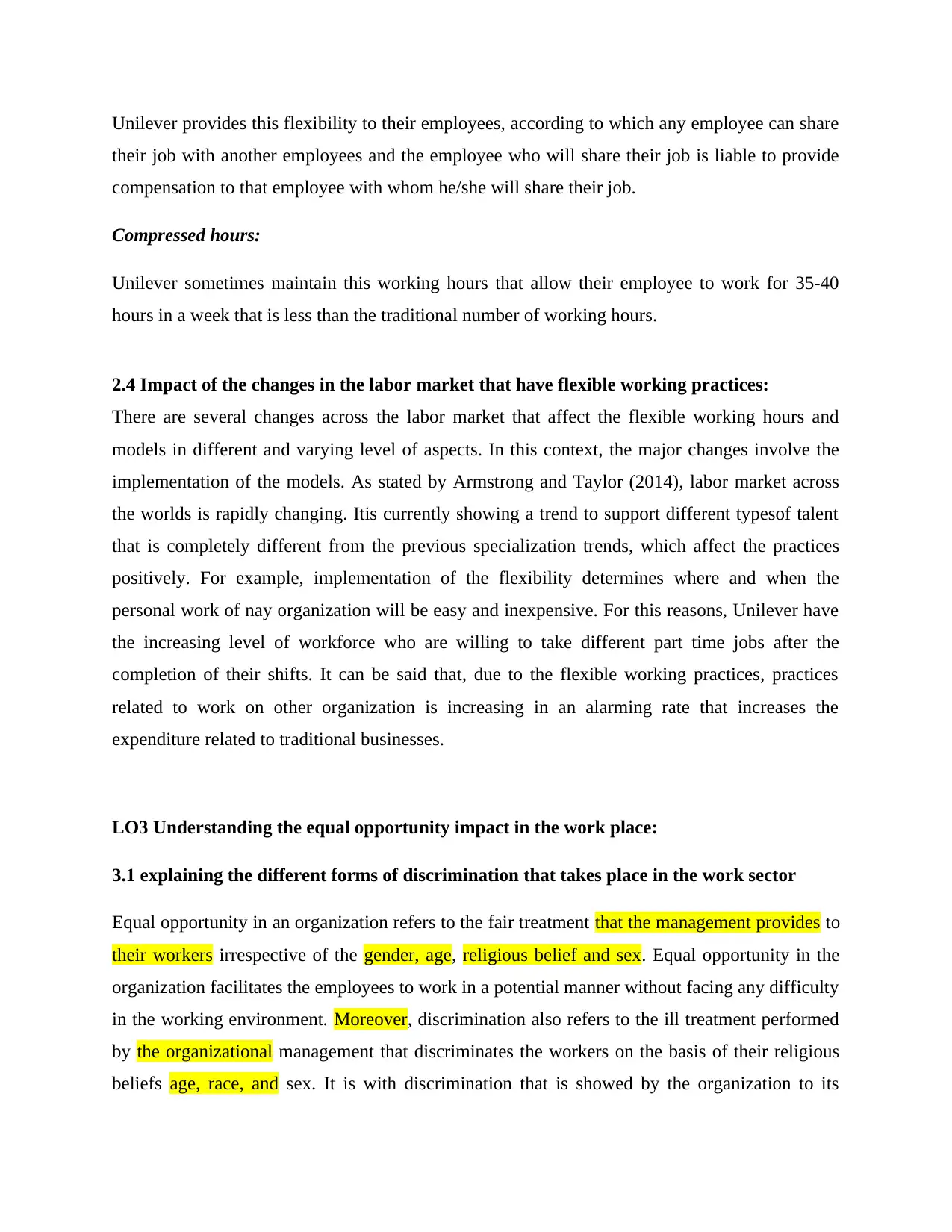
Unilever provides this flexibility to their employees, according to which any employee can share
their job with another employees and the employee who will share their job is liable to provide
compensation to that employee with whom he/she will share their job.
Compressed hours:
Unilever sometimes maintain this working hours that allow their employee to work for 35-40
hours in a week that is less than the traditional number of working hours.
2.4 Impact of the changes in the labor market that have flexible working practices:
There are several changes across the labor market that affect the flexible working hours and
models in different and varying level of aspects. In this context, the major changes involve the
implementation of the models. As stated by Armstrong and Taylor (2014), labor market across
the worlds is rapidly changing. Itis currently showing a trend to support different typesof talent
that is completely different from the previous specialization trends, which affect the practices
positively. For example, implementation of the flexibility determines where and when the
personal work of nay organization will be easy and inexpensive. For this reasons, Unilever have
the increasing level of workforce who are willing to take different part time jobs after the
completion of their shifts. It can be said that, due to the flexible working practices, practices
related to work on other organization is increasing in an alarming rate that increases the
expenditure related to traditional businesses.
LO3 Understanding the equal opportunity impact in the work place:
3.1 explaining the different forms of discrimination that takes place in the work sector
Equal opportunity in an organization refers to the fair treatment that the management provides to
their workers irrespective of the gender, age, religious belief and sex. Equal opportunity in the
organization facilitates the employees to work in a potential manner without facing any difficulty
in the working environment. Moreover, discrimination also refers to the ill treatment performed
by the organizational management that discriminates the workers on the basis of their religious
beliefs age, race, and sex. It is with discrimination that is showed by the organization to its
their job with another employees and the employee who will share their job is liable to provide
compensation to that employee with whom he/she will share their job.
Compressed hours:
Unilever sometimes maintain this working hours that allow their employee to work for 35-40
hours in a week that is less than the traditional number of working hours.
2.4 Impact of the changes in the labor market that have flexible working practices:
There are several changes across the labor market that affect the flexible working hours and
models in different and varying level of aspects. In this context, the major changes involve the
implementation of the models. As stated by Armstrong and Taylor (2014), labor market across
the worlds is rapidly changing. Itis currently showing a trend to support different typesof talent
that is completely different from the previous specialization trends, which affect the practices
positively. For example, implementation of the flexibility determines where and when the
personal work of nay organization will be easy and inexpensive. For this reasons, Unilever have
the increasing level of workforce who are willing to take different part time jobs after the
completion of their shifts. It can be said that, due to the flexible working practices, practices
related to work on other organization is increasing in an alarming rate that increases the
expenditure related to traditional businesses.
LO3 Understanding the equal opportunity impact in the work place:
3.1 explaining the different forms of discrimination that takes place in the work sector
Equal opportunity in an organization refers to the fair treatment that the management provides to
their workers irrespective of the gender, age, religious belief and sex. Equal opportunity in the
organization facilitates the employees to work in a potential manner without facing any difficulty
in the working environment. Moreover, discrimination also refers to the ill treatment performed
by the organizational management that discriminates the workers on the basis of their religious
beliefs age, race, and sex. It is with discrimination that is showed by the organization to its
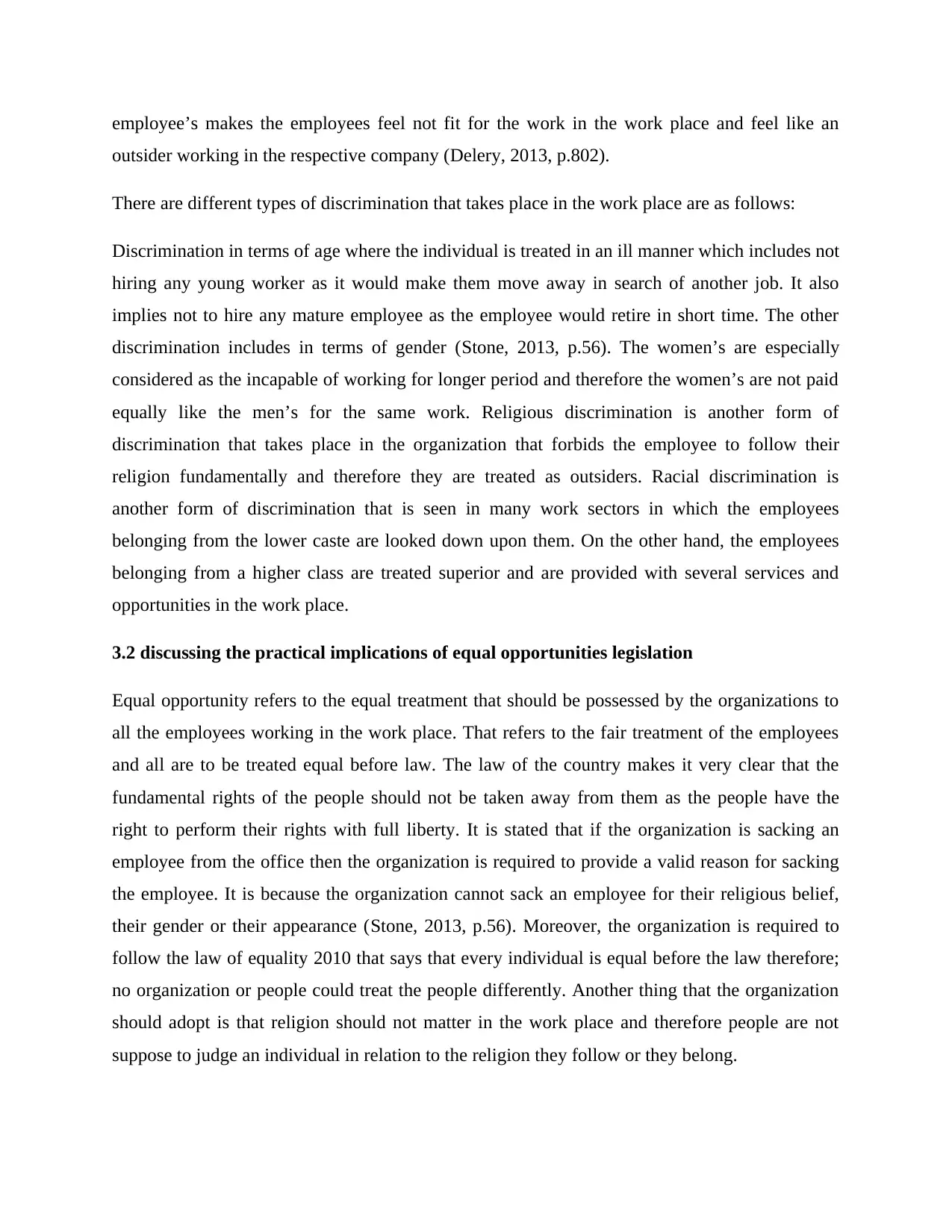
employee’s makes the employees feel not fit for the work in the work place and feel like an
outsider working in the respective company (Delery, 2013, p.802).
There are different types of discrimination that takes place in the work place are as follows:
Discrimination in terms of age where the individual is treated in an ill manner which includes not
hiring any young worker as it would make them move away in search of another job. It also
implies not to hire any mature employee as the employee would retire in short time. The other
discrimination includes in terms of gender (Stone, 2013, p.56). The women’s are especially
considered as the incapable of working for longer period and therefore the women’s are not paid
equally like the men’s for the same work. Religious discrimination is another form of
discrimination that takes place in the organization that forbids the employee to follow their
religion fundamentally and therefore they are treated as outsiders. Racial discrimination is
another form of discrimination that is seen in many work sectors in which the employees
belonging from the lower caste are looked down upon them. On the other hand, the employees
belonging from a higher class are treated superior and are provided with several services and
opportunities in the work place.
3.2 discussing the practical implications of equal opportunities legislation
Equal opportunity refers to the equal treatment that should be possessed by the organizations to
all the employees working in the work place. That refers to the fair treatment of the employees
and all are to be treated equal before law. The law of the country makes it very clear that the
fundamental rights of the people should not be taken away from them as the people have the
right to perform their rights with full liberty. It is stated that if the organization is sacking an
employee from the office then the organization is required to provide a valid reason for sacking
the employee. It is because the organization cannot sack an employee for their religious belief,
their gender or their appearance (Stone, 2013, p.56). Moreover, the organization is required to
follow the law of equality 2010 that says that every individual is equal before the law therefore;
no organization or people could treat the people differently. Another thing that the organization
should adopt is that religion should not matter in the work place and therefore people are not
suppose to judge an individual in relation to the religion they follow or they belong.
outsider working in the respective company (Delery, 2013, p.802).
There are different types of discrimination that takes place in the work place are as follows:
Discrimination in terms of age where the individual is treated in an ill manner which includes not
hiring any young worker as it would make them move away in search of another job. It also
implies not to hire any mature employee as the employee would retire in short time. The other
discrimination includes in terms of gender (Stone, 2013, p.56). The women’s are especially
considered as the incapable of working for longer period and therefore the women’s are not paid
equally like the men’s for the same work. Religious discrimination is another form of
discrimination that takes place in the organization that forbids the employee to follow their
religion fundamentally and therefore they are treated as outsiders. Racial discrimination is
another form of discrimination that is seen in many work sectors in which the employees
belonging from the lower caste are looked down upon them. On the other hand, the employees
belonging from a higher class are treated superior and are provided with several services and
opportunities in the work place.
3.2 discussing the practical implications of equal opportunities legislation
Equal opportunity refers to the equal treatment that should be possessed by the organizations to
all the employees working in the work place. That refers to the fair treatment of the employees
and all are to be treated equal before law. The law of the country makes it very clear that the
fundamental rights of the people should not be taken away from them as the people have the
right to perform their rights with full liberty. It is stated that if the organization is sacking an
employee from the office then the organization is required to provide a valid reason for sacking
the employee. It is because the organization cannot sack an employee for their religious belief,
their gender or their appearance (Stone, 2013, p.56). Moreover, the organization is required to
follow the law of equality 2010 that says that every individual is equal before the law therefore;
no organization or people could treat the people differently. Another thing that the organization
should adopt is that religion should not matter in the work place and therefore people are not
suppose to judge an individual in relation to the religion they follow or they belong.
Secure Best Marks with AI Grader
Need help grading? Try our AI Grader for instant feedback on your assignments.
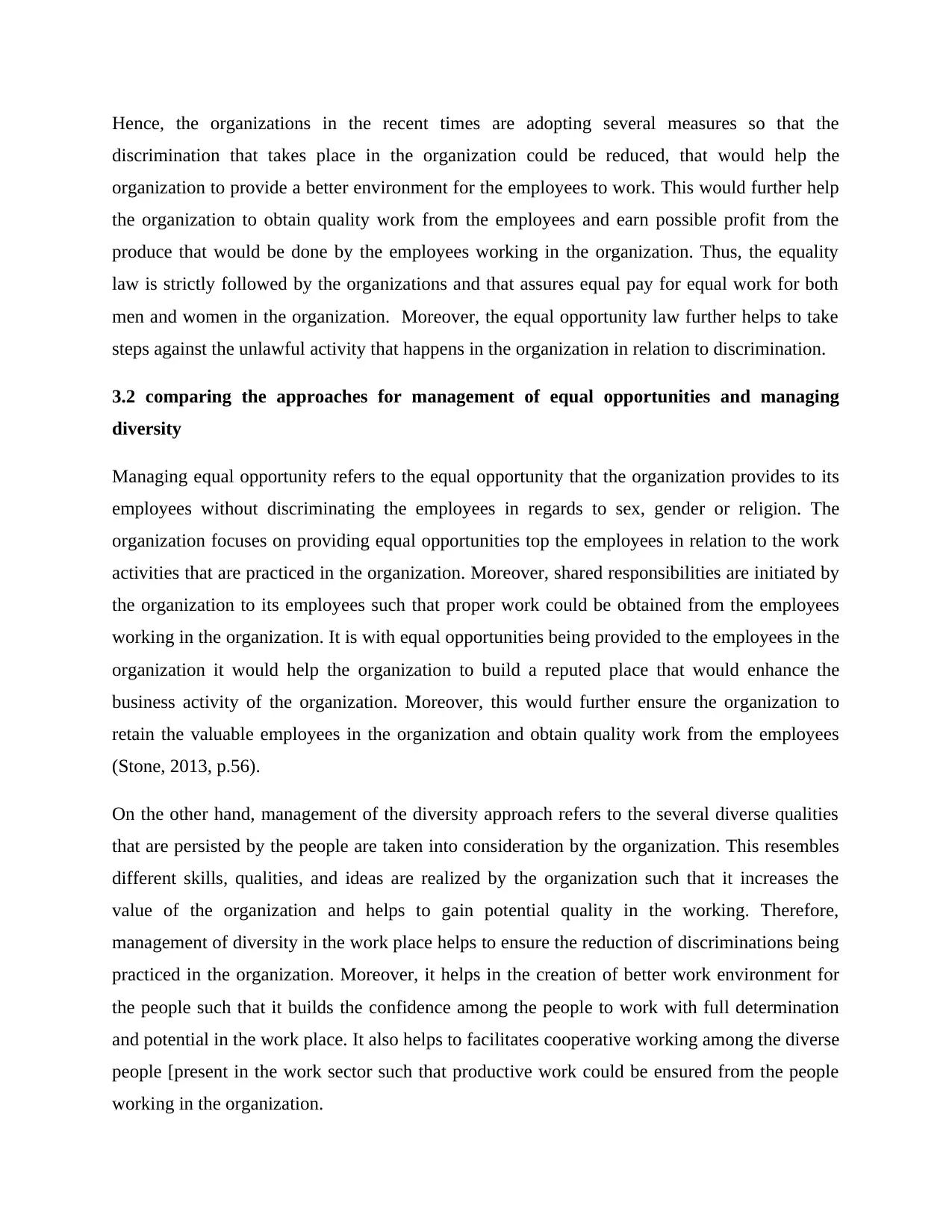
Hence, the organizations in the recent times are adopting several measures so that the
discrimination that takes place in the organization could be reduced, that would help the
organization to provide a better environment for the employees to work. This would further help
the organization to obtain quality work from the employees and earn possible profit from the
produce that would be done by the employees working in the organization. Thus, the equality
law is strictly followed by the organizations and that assures equal pay for equal work for both
men and women in the organization. Moreover, the equal opportunity law further helps to take
steps against the unlawful activity that happens in the organization in relation to discrimination.
3.2 comparing the approaches for management of equal opportunities and managing
diversity
Managing equal opportunity refers to the equal opportunity that the organization provides to its
employees without discriminating the employees in regards to sex, gender or religion. The
organization focuses on providing equal opportunities top the employees in relation to the work
activities that are practiced in the organization. Moreover, shared responsibilities are initiated by
the organization to its employees such that proper work could be obtained from the employees
working in the organization. It is with equal opportunities being provided to the employees in the
organization it would help the organization to build a reputed place that would enhance the
business activity of the organization. Moreover, this would further ensure the organization to
retain the valuable employees in the organization and obtain quality work from the employees
(Stone, 2013, p.56).
On the other hand, management of the diversity approach refers to the several diverse qualities
that are persisted by the people are taken into consideration by the organization. This resembles
different skills, qualities, and ideas are realized by the organization such that it increases the
value of the organization and helps to gain potential quality in the working. Therefore,
management of diversity in the work place helps to ensure the reduction of discriminations being
practiced in the organization. Moreover, it helps in the creation of better work environment for
the people such that it builds the confidence among the people to work with full determination
and potential in the work place. It also helps to facilitates cooperative working among the diverse
people [present in the work sector such that productive work could be ensured from the people
working in the organization.
discrimination that takes place in the organization could be reduced, that would help the
organization to provide a better environment for the employees to work. This would further help
the organization to obtain quality work from the employees and earn possible profit from the
produce that would be done by the employees working in the organization. Thus, the equality
law is strictly followed by the organizations and that assures equal pay for equal work for both
men and women in the organization. Moreover, the equal opportunity law further helps to take
steps against the unlawful activity that happens in the organization in relation to discrimination.
3.2 comparing the approaches for management of equal opportunities and managing
diversity
Managing equal opportunity refers to the equal opportunity that the organization provides to its
employees without discriminating the employees in regards to sex, gender or religion. The
organization focuses on providing equal opportunities top the employees in relation to the work
activities that are practiced in the organization. Moreover, shared responsibilities are initiated by
the organization to its employees such that proper work could be obtained from the employees
working in the organization. It is with equal opportunities being provided to the employees in the
organization it would help the organization to build a reputed place that would enhance the
business activity of the organization. Moreover, this would further ensure the organization to
retain the valuable employees in the organization and obtain quality work from the employees
(Stone, 2013, p.56).
On the other hand, management of the diversity approach refers to the several diverse qualities
that are persisted by the people are taken into consideration by the organization. This resembles
different skills, qualities, and ideas are realized by the organization such that it increases the
value of the organization and helps to gain potential quality in the working. Therefore,
management of diversity in the work place helps to ensure the reduction of discriminations being
practiced in the organization. Moreover, it helps in the creation of better work environment for
the people such that it builds the confidence among the people to work with full determination
and potential in the work place. It also helps to facilitates cooperative working among the diverse
people [present in the work sector such that productive work could be ensured from the people
working in the organization.
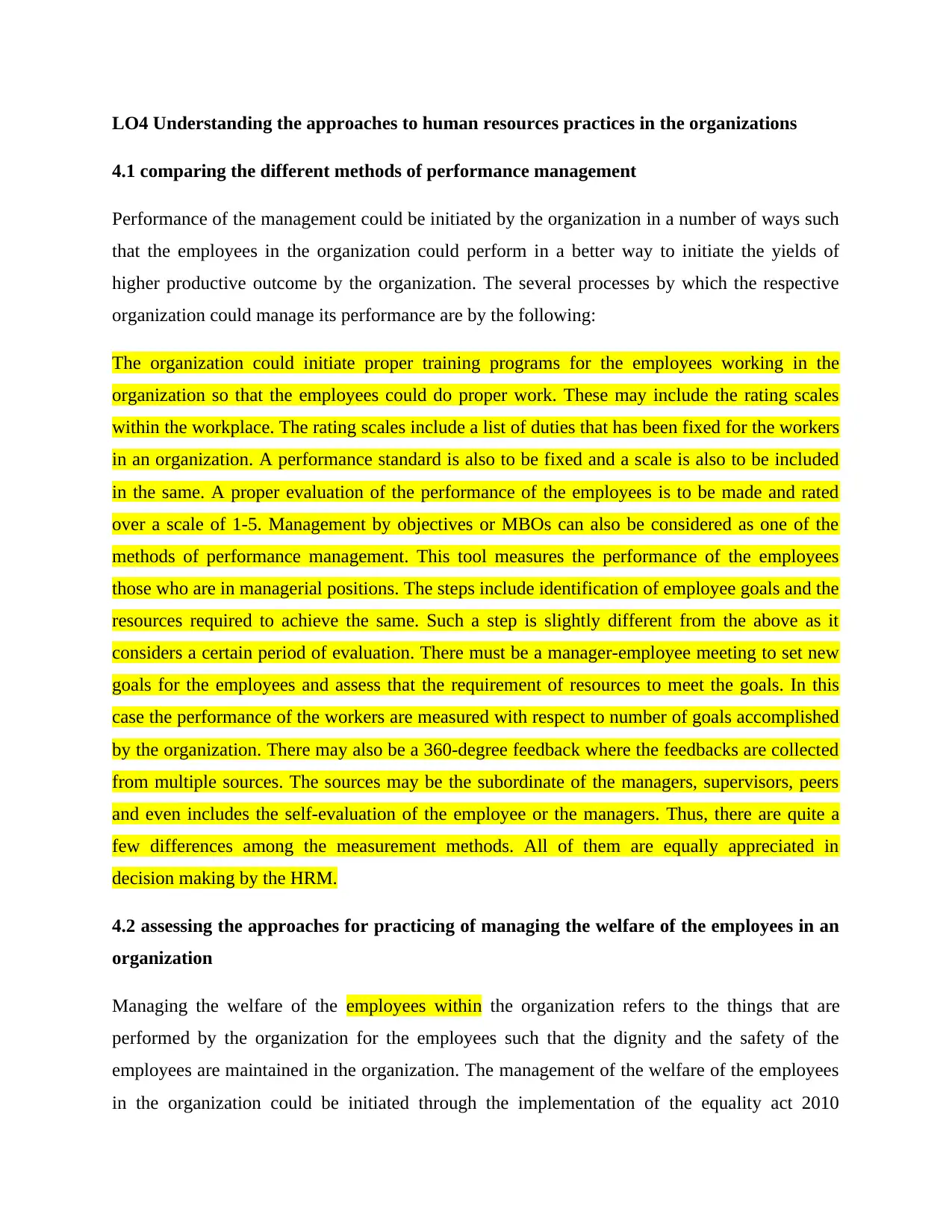
LO4 Understanding the approaches to human resources practices in the organizations
4.1 comparing the different methods of performance management
Performance of the management could be initiated by the organization in a number of ways such
that the employees in the organization could perform in a better way to initiate the yields of
higher productive outcome by the organization. The several processes by which the respective
organization could manage its performance are by the following:
The organization could initiate proper training programs for the employees working in the
organization so that the employees could do proper work. These may include the rating scales
within the workplace. The rating scales include a list of duties that has been fixed for the workers
in an organization. A performance standard is also to be fixed and a scale is also to be included
in the same. A proper evaluation of the performance of the employees is to be made and rated
over a scale of 1-5. Management by objectives or MBOs can also be considered as one of the
methods of performance management. This tool measures the performance of the employees
those who are in managerial positions. The steps include identification of employee goals and the
resources required to achieve the same. Such a step is slightly different from the above as it
considers a certain period of evaluation. There must be a manager-employee meeting to set new
goals for the employees and assess that the requirement of resources to meet the goals. In this
case the performance of the workers are measured with respect to number of goals accomplished
by the organization. There may also be a 360-degree feedback where the feedbacks are collected
from multiple sources. The sources may be the subordinate of the managers, supervisors, peers
and even includes the self-evaluation of the employee or the managers. Thus, there are quite a
few differences among the measurement methods. All of them are equally appreciated in
decision making by the HRM.
4.2 assessing the approaches for practicing of managing the welfare of the employees in an
organization
Managing the welfare of the employees within the organization refers to the things that are
performed by the organization for the employees such that the dignity and the safety of the
employees are maintained in the organization. The management of the welfare of the employees
in the organization could be initiated through the implementation of the equality act 2010
4.1 comparing the different methods of performance management
Performance of the management could be initiated by the organization in a number of ways such
that the employees in the organization could perform in a better way to initiate the yields of
higher productive outcome by the organization. The several processes by which the respective
organization could manage its performance are by the following:
The organization could initiate proper training programs for the employees working in the
organization so that the employees could do proper work. These may include the rating scales
within the workplace. The rating scales include a list of duties that has been fixed for the workers
in an organization. A performance standard is also to be fixed and a scale is also to be included
in the same. A proper evaluation of the performance of the employees is to be made and rated
over a scale of 1-5. Management by objectives or MBOs can also be considered as one of the
methods of performance management. This tool measures the performance of the employees
those who are in managerial positions. The steps include identification of employee goals and the
resources required to achieve the same. Such a step is slightly different from the above as it
considers a certain period of evaluation. There must be a manager-employee meeting to set new
goals for the employees and assess that the requirement of resources to meet the goals. In this
case the performance of the workers are measured with respect to number of goals accomplished
by the organization. There may also be a 360-degree feedback where the feedbacks are collected
from multiple sources. The sources may be the subordinate of the managers, supervisors, peers
and even includes the self-evaluation of the employee or the managers. Thus, there are quite a
few differences among the measurement methods. All of them are equally appreciated in
decision making by the HRM.
4.2 assessing the approaches for practicing of managing the welfare of the employees in an
organization
Managing the welfare of the employees within the organization refers to the things that are
performed by the organization for the employees such that the dignity and the safety of the
employees are maintained in the organization. The management of the welfare of the employees
in the organization could be initiated through the implementation of the equality act 2010
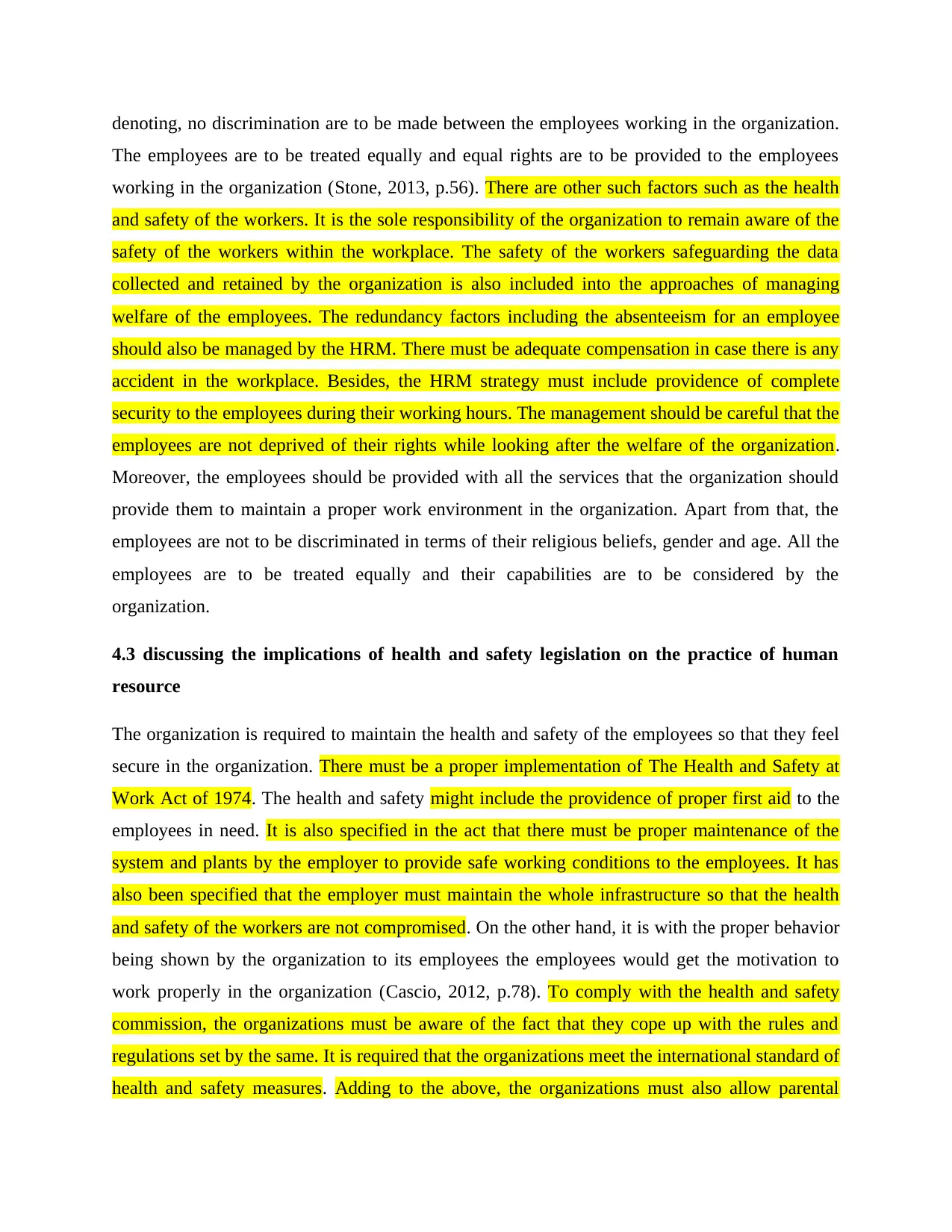
denoting, no discrimination are to be made between the employees working in the organization.
The employees are to be treated equally and equal rights are to be provided to the employees
working in the organization (Stone, 2013, p.56). There are other such factors such as the health
and safety of the workers. It is the sole responsibility of the organization to remain aware of the
safety of the workers within the workplace. The safety of the workers safeguarding the data
collected and retained by the organization is also included into the approaches of managing
welfare of the employees. The redundancy factors including the absenteeism for an employee
should also be managed by the HRM. There must be adequate compensation in case there is any
accident in the workplace. Besides, the HRM strategy must include providence of complete
security to the employees during their working hours. The management should be careful that the
employees are not deprived of their rights while looking after the welfare of the organization.
Moreover, the employees should be provided with all the services that the organization should
provide them to maintain a proper work environment in the organization. Apart from that, the
employees are not to be discriminated in terms of their religious beliefs, gender and age. All the
employees are to be treated equally and their capabilities are to be considered by the
organization.
4.3 discussing the implications of health and safety legislation on the practice of human
resource
The organization is required to maintain the health and safety of the employees so that they feel
secure in the organization. There must be a proper implementation of The Health and Safety at
Work Act of 1974. The health and safety might include the providence of proper first aid to the
employees in need. It is also specified in the act that there must be proper maintenance of the
system and plants by the employer to provide safe working conditions to the employees. It has
also been specified that the employer must maintain the whole infrastructure so that the health
and safety of the workers are not compromised. On the other hand, it is with the proper behavior
being shown by the organization to its employees the employees would get the motivation to
work properly in the organization (Cascio, 2012, p.78). To comply with the health and safety
commission, the organizations must be aware of the fact that they cope up with the rules and
regulations set by the same. It is required that the organizations meet the international standard of
health and safety measures. Adding to the above, the organizations must also allow parental
The employees are to be treated equally and equal rights are to be provided to the employees
working in the organization (Stone, 2013, p.56). There are other such factors such as the health
and safety of the workers. It is the sole responsibility of the organization to remain aware of the
safety of the workers within the workplace. The safety of the workers safeguarding the data
collected and retained by the organization is also included into the approaches of managing
welfare of the employees. The redundancy factors including the absenteeism for an employee
should also be managed by the HRM. There must be adequate compensation in case there is any
accident in the workplace. Besides, the HRM strategy must include providence of complete
security to the employees during their working hours. The management should be careful that the
employees are not deprived of their rights while looking after the welfare of the organization.
Moreover, the employees should be provided with all the services that the organization should
provide them to maintain a proper work environment in the organization. Apart from that, the
employees are not to be discriminated in terms of their religious beliefs, gender and age. All the
employees are to be treated equally and their capabilities are to be considered by the
organization.
4.3 discussing the implications of health and safety legislation on the practice of human
resource
The organization is required to maintain the health and safety of the employees so that they feel
secure in the organization. There must be a proper implementation of The Health and Safety at
Work Act of 1974. The health and safety might include the providence of proper first aid to the
employees in need. It is also specified in the act that there must be proper maintenance of the
system and plants by the employer to provide safe working conditions to the employees. It has
also been specified that the employer must maintain the whole infrastructure so that the health
and safety of the workers are not compromised. On the other hand, it is with the proper behavior
being shown by the organization to its employees the employees would get the motivation to
work properly in the organization (Cascio, 2012, p.78). To comply with the health and safety
commission, the organizations must be aware of the fact that they cope up with the rules and
regulations set by the same. It is required that the organizations meet the international standard of
health and safety measures. Adding to the above, the organizations must also allow parental
Paraphrase This Document
Need a fresh take? Get an instant paraphrase of this document with our AI Paraphraser
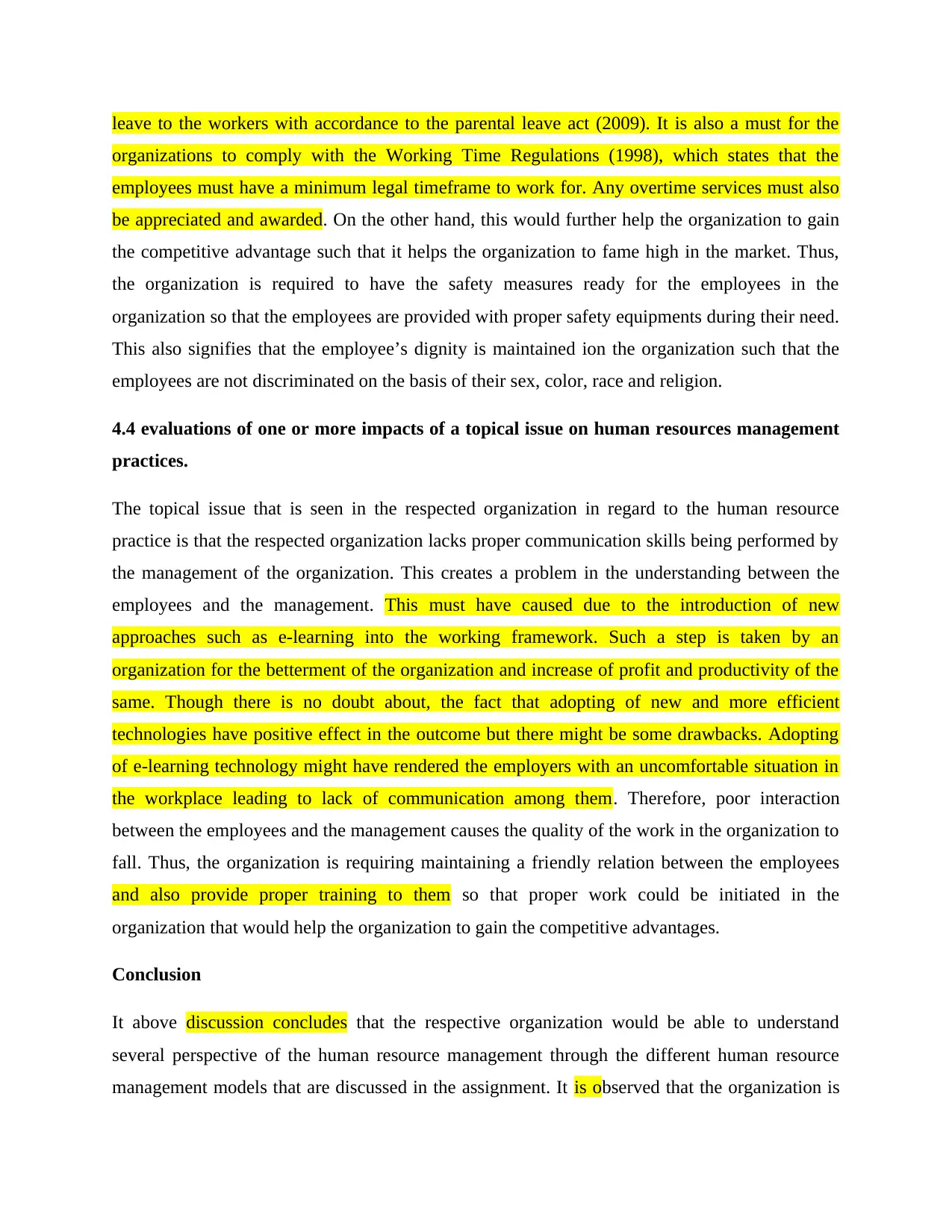
leave to the workers with accordance to the parental leave act (2009). It is also a must for the
organizations to comply with the Working Time Regulations (1998), which states that the
employees must have a minimum legal timeframe to work for. Any overtime services must also
be appreciated and awarded. On the other hand, this would further help the organization to gain
the competitive advantage such that it helps the organization to fame high in the market. Thus,
the organization is required to have the safety measures ready for the employees in the
organization so that the employees are provided with proper safety equipments during their need.
This also signifies that the employee’s dignity is maintained ion the organization such that the
employees are not discriminated on the basis of their sex, color, race and religion.
4.4 evaluations of one or more impacts of a topical issue on human resources management
practices.
The topical issue that is seen in the respected organization in regard to the human resource
practice is that the respected organization lacks proper communication skills being performed by
the management of the organization. This creates a problem in the understanding between the
employees and the management. This must have caused due to the introduction of new
approaches such as e-learning into the working framework. Such a step is taken by an
organization for the betterment of the organization and increase of profit and productivity of the
same. Though there is no doubt about, the fact that adopting of new and more efficient
technologies have positive effect in the outcome but there might be some drawbacks. Adopting
of e-learning technology might have rendered the employers with an uncomfortable situation in
the workplace leading to lack of communication among them. Therefore, poor interaction
between the employees and the management causes the quality of the work in the organization to
fall. Thus, the organization is requiring maintaining a friendly relation between the employees
and also provide proper training to them so that proper work could be initiated in the
organization that would help the organization to gain the competitive advantages.
Conclusion
It above discussion concludes that the respective organization would be able to understand
several perspective of the human resource management through the different human resource
management models that are discussed in the assignment. It is observed that the organization is
organizations to comply with the Working Time Regulations (1998), which states that the
employees must have a minimum legal timeframe to work for. Any overtime services must also
be appreciated and awarded. On the other hand, this would further help the organization to gain
the competitive advantage such that it helps the organization to fame high in the market. Thus,
the organization is required to have the safety measures ready for the employees in the
organization so that the employees are provided with proper safety equipments during their need.
This also signifies that the employee’s dignity is maintained ion the organization such that the
employees are not discriminated on the basis of their sex, color, race and religion.
4.4 evaluations of one or more impacts of a topical issue on human resources management
practices.
The topical issue that is seen in the respected organization in regard to the human resource
practice is that the respected organization lacks proper communication skills being performed by
the management of the organization. This creates a problem in the understanding between the
employees and the management. This must have caused due to the introduction of new
approaches such as e-learning into the working framework. Such a step is taken by an
organization for the betterment of the organization and increase of profit and productivity of the
same. Though there is no doubt about, the fact that adopting of new and more efficient
technologies have positive effect in the outcome but there might be some drawbacks. Adopting
of e-learning technology might have rendered the employers with an uncomfortable situation in
the workplace leading to lack of communication among them. Therefore, poor interaction
between the employees and the management causes the quality of the work in the organization to
fall. Thus, the organization is requiring maintaining a friendly relation between the employees
and also provide proper training to them so that proper work could be initiated in the
organization that would help the organization to gain the competitive advantages.
Conclusion
It above discussion concludes that the respective organization would be able to understand
several perspective of the human resource management through the different human resource
management models that are discussed in the assignment. It is observed that the organization is
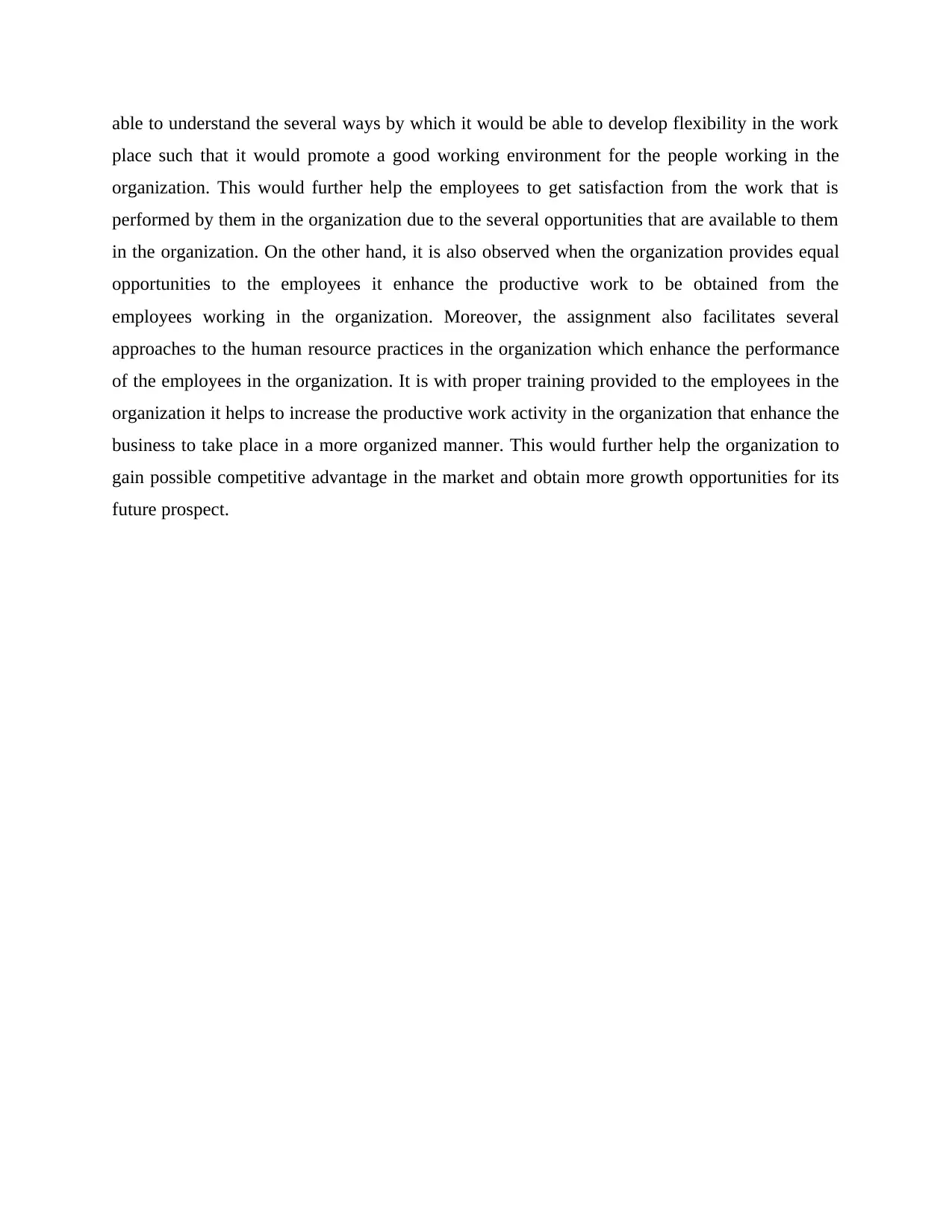
able to understand the several ways by which it would be able to develop flexibility in the work
place such that it would promote a good working environment for the people working in the
organization. This would further help the employees to get satisfaction from the work that is
performed by them in the organization due to the several opportunities that are available to them
in the organization. On the other hand, it is also observed when the organization provides equal
opportunities to the employees it enhance the productive work to be obtained from the
employees working in the organization. Moreover, the assignment also facilitates several
approaches to the human resource practices in the organization which enhance the performance
of the employees in the organization. It is with proper training provided to the employees in the
organization it helps to increase the productive work activity in the organization that enhance the
business to take place in a more organized manner. This would further help the organization to
gain possible competitive advantage in the market and obtain more growth opportunities for its
future prospect.
place such that it would promote a good working environment for the people working in the
organization. This would further help the employees to get satisfaction from the work that is
performed by them in the organization due to the several opportunities that are available to them
in the organization. On the other hand, it is also observed when the organization provides equal
opportunities to the employees it enhance the productive work to be obtained from the
employees working in the organization. Moreover, the assignment also facilitates several
approaches to the human resource practices in the organization which enhance the performance
of the employees in the organization. It is with proper training provided to the employees in the
organization it helps to increase the productive work activity in the organization that enhance the
business to take place in a more organized manner. This would further help the organization to
gain possible competitive advantage in the market and obtain more growth opportunities for its
future prospect.
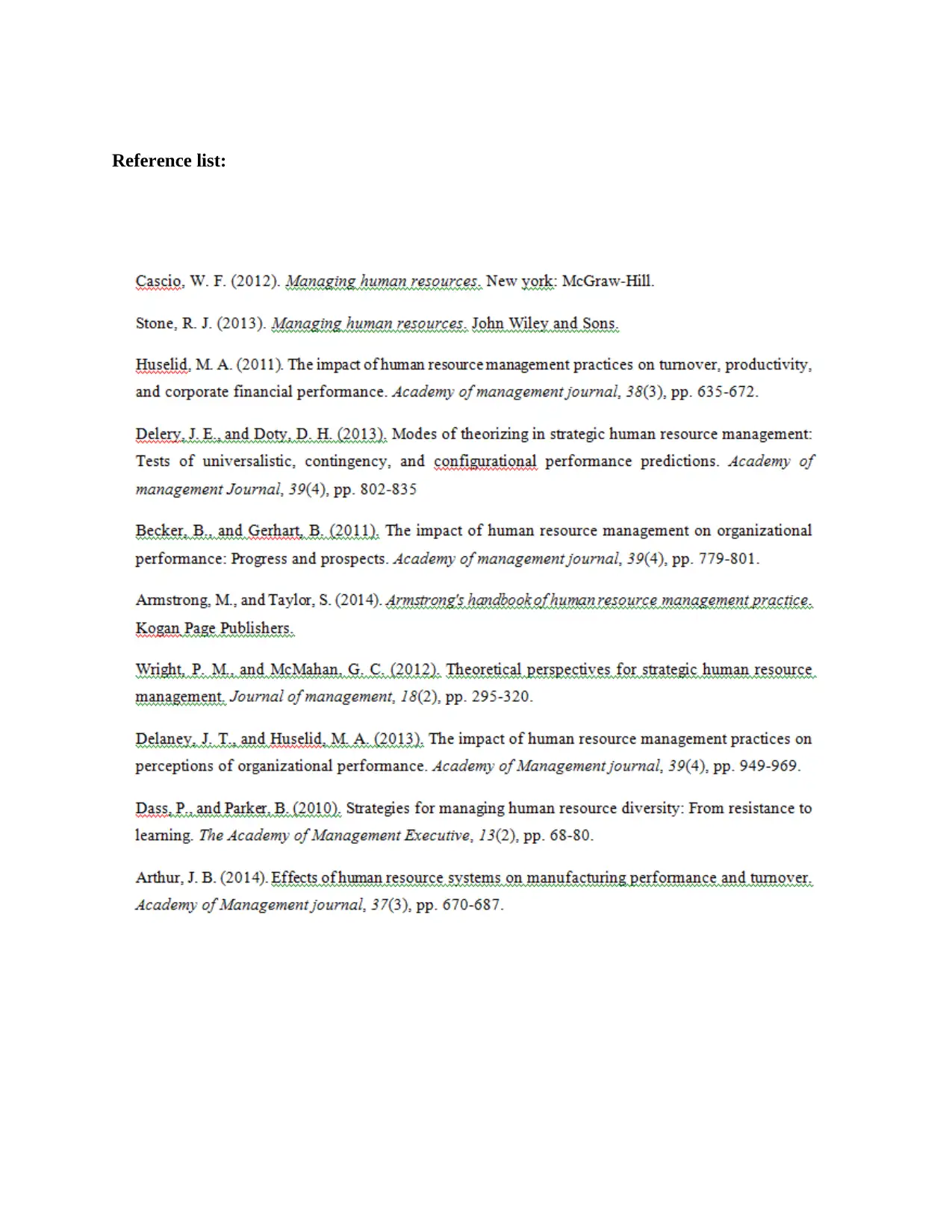
Reference list:
1 out of 16
Related Documents
Your All-in-One AI-Powered Toolkit for Academic Success.
+13062052269
info@desklib.com
Available 24*7 on WhatsApp / Email
![[object Object]](/_next/static/media/star-bottom.7253800d.svg)
Unlock your academic potential
© 2024 | Zucol Services PVT LTD | All rights reserved.





